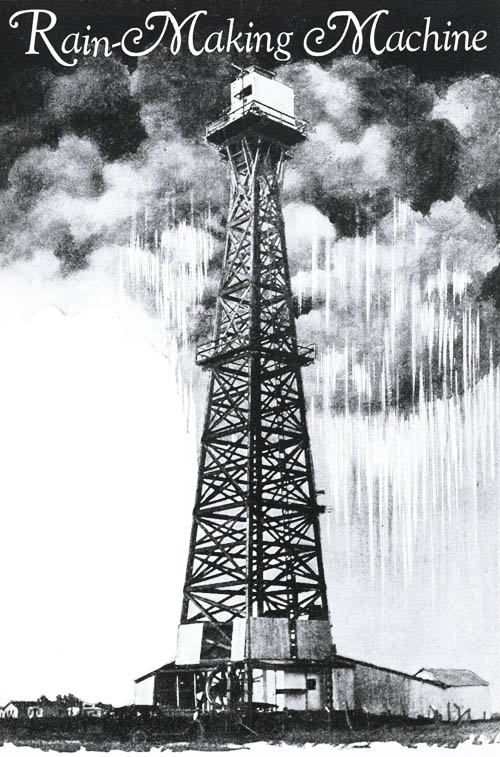Weather Warfare
 [Image: From Elements of War by Kalypso Media].
[Image: From Elements of War by Kalypso Media]. A forthcoming game called Elements of War takes weaponized weather-control as its central theme, "where armies manipulate the forces of nature to rain down destruction on their foes or gain a tactical advantage by transforming the battlefield with hurricanes, tornadoes and earthquakes."
It is set in the United States in a period "after a secret military weather control experiment sets in motion a near-complete global climate collapse," featuring "unconventional units" fighting "for control of fearsome weather-based weapons, granting them the power to use tornadoes, hurricanes, earthquakes, torrential rains and other forces of nature as weapons of war."
 [Image: From Elements of War by Kalypso Media].
[Image: From Elements of War by Kalypso Media]. The game comes out in February 2011, so I haven't played it and am basing this solely on a recent press release; I thus can't vouch for its actual execution or gameplay.
Nonetheless, I'm intrigued to see how the game's "six weather-based weapons," allowing players to "dominate and transform the battlefield with tornadoes, earthquakes, hurricanes and other elements of war, impacting supply lines, slowing troop movements and devastating the enemy," work out.
 [Image: From Elements of War by Kalypso Media].
[Image: From Elements of War by Kalypso Media]. The game promises "realistic destruction physics," and I would hope that the weapons themselves—there is apparently an internal game list of what the designers call "'What If' Weaponry"—are actually interesting, and not just repurposed tanks, their cannons firing storms, or rifles shooting electrically-active lightning rounds or something similar.
In fact, the possibilities for genuinely reinvented tools of weather-warfare become pretty delirious after a point, whether it's something as basic as shoulder-fired devices packed with microtornadic winds or whole fields sown with air-pressure bombs that generate inland hurricanes upon timed detonation.
Long-term seismic-resonance grenades; liquefaction earth-storms; Instant Glacier™ humidity-solidification traps; stationary magnetosphere-deflection architecture.
 [Image: A "rain-making machine" via Modern Mechanix].
[Image: A "rain-making machine" via Modern Mechanix]. In an article I often cite here, originally published in The Wilson Quarterly, weather historian James Fleming explains that, as early as World War II, "some in the military had already recognized the potential uses of weather modification, and the subject has remained on military minds ever since. In the 1940s, General George C. Kenney, commander of the Strategic Air Command, declared, 'The nation which first learns to plot the paths of air masses accurately and learns to control the time and place of precipitation will dominate the globe.'"
Fleming continues:
- Howard T. Orville, President Dwight D. Eisenhower’s weather adviser, published an influential 1954 article in Collier’s that included a variety of scenarios for using weather as a weapon of warfare. Planes would drop hundreds of balloons containing seeding crystals into the jet stream. Downstream, when the fuses on the balloons exploded, the crystals would fall into the clouds, initiating rain and miring enemy operations. The Army Ordnance Corps was investigating another technique: loading silver iodide and carbon dioxide into 50-caliber tracer bullets that pilots could fire into clouds. A more insidious technique would strike at an adversary’s food supply by seeding clouds to rob them of moisture before they reached enemy agricultural areas. Speculative and wildly optimistic ideas such as these from official sources, together with threats that the Soviets were aggressively pursuing weather control, triggered what Newsweek called “a weather race with the Russians,” and helped fuel the rapid expansion of meteorological research in all areas, including the creation of the National Center for Atmospheric Research, which was established in 1960.
In any case, I could go on and on about weaponized climatology; for now, it seems no surprise that weather-weapons would be making their way as offensive tools into new computer games.
(Via Jim Rossignol; earlier on BLDGBLOG: Tactical Landscaping and Terrain Deformation).





Comments are moderated.
If it's not spam, it will appear here shortly!
It is a terrifying premise that we could potentially manipulate the weather before we could ever accurately predict it.
must be true. I was in the 54th at anderson afb guam. It rained every 5 min. was also at udorn thailand. They needed rain windstarwillie
Post a Comment